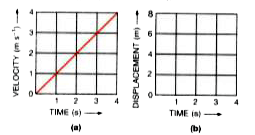STATEMENT - 1 : The diagram below depicts the path of a person walking to and fro from position A to B to C to D. The distance for this motion is 100 yds.
STATEMENT - 2 : For the same diagram below, the displacement is 50 yds

STATEMENT - 3 : Position-time graphs cannot be used to represent the motion of object with accelerated motion.
TTT
FTF
FFF
TFF
The correct Answer is:C
Step by step video & image solution for STATEMENT - 1 : The diagram below depicts the path of a person walking to and fro from position A to B to C to D. The distance for this motion is 100 yds. STATEMENT - 2 : For the same diagram below, the displacement is 50 yds STATEMENT - 3 : Position-time graphs cannot be used to represent the motion of object with accelerated motion. by Physics experts to help you in doubts & scoring excellent marks in Class 12 exams.
Updated on:21/07/2023Topper's Solved these Questions
- MOTION IN STRAIGHT LINEBOOK - AAKASH INSTITUTE ENGLISHCHAPTER - MOTION IN STRAIGHT LINEEXERCISE - Assignment (SECTION - I)
3 Videos
- MOTION IN STRAIGHT LINEBOOK - AAKASH INSTITUTE ENGLISHCHAPTER - MOTION IN STRAIGHT LINEEXERCISE - Assignment (SECTION - J)
2 Videos
- MOTION IN STRAIGHT LINEBOOK - AAKASH INSTITUTE ENGLISHCHAPTER - MOTION IN STRAIGHT LINEEXERCISE - Assignment (SECTION - G)
4 Videos
- MOTION IN A STRAIGHT LINEBOOK - AAKASH INSTITUTE ENGLISHCHAPTER - MOTION IN A STRAIGHT LINEEXERCISE - ASSIGNMENT (SECTION - D)
15 Videos
- MOVING CHARGE AND MAGNESIUMBOOK - AAKASH INSTITUTE ENGLISHCHAPTER - MOVING CHARGE AND MAGNESIUMEXERCISE - SECTION D
16 Videos
Similar Questions
STATEMENT - 1 : The instantaneous velocity is always tangential to the path
and
STATEMENT - 2 : The slope of position-time graph represents the velocity.
View SolutionSTATEMENT - 1 : If the body is moving in the opposite direction of positive motion, then its speed is negative.
STATEMENT - 2 : A scalar quantity is one that must be dimensionless.
STATEMENT - 3 : A body is momentarily at rest when it reverse its direction of motion.
View SolutionSTATEMENT - 1 : If person walks in a straight line and never changes direction, then the distance and the displacement will have exactly the same magnitude.
STATEMENT - 2 : The phrase ''20 m, northwest'' likely describe the distance for a motion.
STATEMENT - 3 : The phrase ''20 m, west'' likely describes the displacement for a motion
View SolutionSTATEMENT - 1 : The slope on a position-time graph is representative of the acceleration of the object.
STATEMENT - 2 : A straight, diagonal line on a position-time graph is representative of an onject with a constant velocity.
STATEMENT - 3 : I an object is at rest, then the position-time graph must be a horizontal line located on the time-axis.
View SolutionSTATEMENT-1 : A particle executing simple harmonic motion comes to rest at the extreme positions.
STATEMENT-2 : Displacement and velocity of SHM differ in phase by π2 rad.
STATEMENT- 3 : Soldiers are asked to break steps while crossing the bridges.
View SolutionSTATEMENT - 1 : Distance is a vector quantity and displacement is a scalar quantity.
STATEMENT - 2 : A person makes a round - trip journey, finishing where she started. The displacement for the trip is 0 and the distance is some nonzero value.
STATEMENT - 3 : A person starts at position A and finishes at position B. The distance for the trip is the length of the segment measured from A to B.
View SolutionSTATEMENT - 1 : All accelerated object are represented on position-time graphs by curved lines.
STATEMENT - 2 : An object with a positive velocity will be represented on a position-time graph by a line with a positive slope.
STATEMENT - 3 : An object with a negative velocity will be represented on a position-time graph by a line with a negative slope.
View SolutionFig. 2.41 (a) shows the velocity-time graph for the motion of a body. Use it to find the displacement of the body at t = 1 s, 2 s, 3 s and 4 s, then draw the displacement-time graph for it on Fig. 2.41 (b).

View SolutionStatement-1 : SHM is not a periodic motion.
Statement-2 : Periodic motion does not repeat its position after certain interval of time.
View SolutionSTATEMENT - 1 : Two bodies projected vertically upward with different initial speeds cover same distances in last second of their upward journey.
and
STATEMENT - 2 : For uniformly accelerated motion, distance travelled in a time interval before coming to rest does not depend on initial speed.
View Solution
